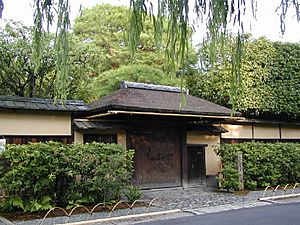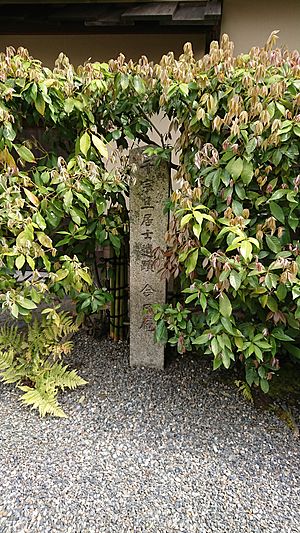Urasenke facts for kids
Urasenke is one of the main schools for the Japanese tea ceremony. It's part of the three main families that teach tea ceremony, all coming from the famous tea master Sen no Rikyū. These three families are called the san-Senke, or "three Sen houses." The other two are Omotesenke and Mushakōjisenke.
The name "Urasenke" means "rear Sen house." This is because their family home was located behind the original main house of the Sen family estate. The Omotesenke (meaning "front Sen house") and Mushakōjisenke (named after a street) also got their names from their locations.
Contents
History of the Urasenke Tea School
The three Sen families all come from the descendants of Sen no Rikyū. He was a very important person in Japanese tea ceremony history, active during the Azuchi-Momoyama period.
Rikyū was from a town called Sakai in what is now Osaka Prefecture. But he also had a house in Kyoto. He asked his adopted son-in-law, Sen Shōan, to move to Kyoto. His natural son, Sen Dōan, stayed in Sakai to look after the family business there. This is how the two main branches of the Sen family started: the Sakai-Senke and the Kyō-Senke.
The Kyō-Senke, led by Sen Shōan, settled in a house on Ogawa Street in Kyoto. This house became the original Sen family estate in Kyoto. After Rikyū died, both Sen Dōan and Sen Shōan had to hide because of the anger of Toyotomi Hideyoshi. Rikyū had died because of Hideyoshi's anger. After some months, both sons were able to return home safely.
Sen Dōan, who lived in Sakai, did not have any children to continue the Sakai-Senke family. But Sen Shōan, back in Kyoto, had a son named Sen no Sōtan. Sōtan became the next head of the Kyō-Senke family.
Sōtan had five children. His first two sons, Kan'ō Sōsetsu and Ichiō Sōshū, were from his first wife. After she passed away, Sōtan remarried and had two more sons, Kōshin Sōsa and Sensō Sōshitsu, and a daughter. His first two sons moved out and lived on their own when they were young. His fourth son, Sensō Sōshitsu, also left to train as a doctor. But the doctor he was training with died, so Sensō came home in 1645. With his father Sōtan's help, Sensō became a tea ceremony expert, just like his older brother Kōshin Sōsa, who was the main heir.
Around 1646, when Sōtan was about 68 years old, he let Kōshin Sōsa take over as the family head. Sōtan moved to a small tea hut called the Konnichian, or "Hut of This Day," at the back of the house. This became Sensō's home base, and Sensō eventually inherited the property.
Sōtan found a job for his eldest son, Ichiō Sōshū, with the Maeda clan. But Ichiō soon left that job, and Sōtan disowned him. Sōtan's second son, Kan'ō Sōsetsu, was adopted by the Yoshioka family in Kyoto, who were famous for making lacquerware. Later in life, Kan'ō returned to the Sen family. He set up a tea room called "Kankyuan" on Mushakōji street and became a tea ceremony expert. This is how the direct family of Sen no Rikyū split into the three lines that are known today as the san-Senke tea schools.
Before the Meiji Restoration in 1868, the heads of these three families worked for different powerful lords, called daimyō. They received money each year for their tea ceremony services. Sensō Shōshitsu, the fourth son and leader of the branch that became Urasenke, served the Maeda clan. Later, the head of the Urasenke family also served the Hisamatsu clan. The eleventh head of the family, Gengensai, married into the Urasenke family and also served the Tokugawa family.
However, after the Tokugawa government fell in 1868, the daimyō lost their power. The money the three Sen families received each year stopped. After losing their jobs with the daimyō, the Sen families created their own system called the iemoto system.
The entire old Urasenke estate in Kyoto is known by the name of its main tea room, the Konnichian.
Headmasters (Iemoto)
All three main Japanese tea ceremony schools share their first three headmasters, known as the iemoto. Sen no Rikyū is the first head and founder. His adopted son-in-law, Sen Shōan, is the second. And Sen Shōan's son, Sen Sōtan, is the third.
From the fourth generation onwards, the three families split into their own lines. The head of each family takes a special professional name. When someone becomes the head of the Urasenke family, they take the name Sōshitsu. The current head of the Urasenke school is Zabōsai Genmoku Sōshitsu. He is the 16th generation of the family and is called Sen Sōshitsu XVI.
| Generation | Name | Religious name | ||
|---|---|---|---|---|
| 1st | Rikyū Sōeki (1522–91) | 利休 宗易 | Hōsensai | 抛筌斎 |
| 2nd | Shōan Sōjun (1546-1614) | 少庵 宗淳 | ||
| 3rd | Genpaku Sōtan (1578-1658) | 元伯 宗旦 | Totsutotsusai | 咄々斎 |
| 4th | Sensō Sōshitsu (1622–97) | 仙叟 宗室 | Rōgetsuan | 臘月庵 |
| 5th | Jōsō Sōshitsu (1673-1704) | 常叟 宗室 | Fukyūsai | 不休斎 |
| 6th | Taisō Sōshitsu (1694-1726) | 泰叟 宗室 | Rikkansai | 六閑斎 |
| 7th | Chikusō Sōshitsu (1709–33) | 竺叟 宗室 | Saisaisai | 最々斎 |
| 8th | Ittō Sōshitsu (1719–71) | 一燈 宗室 | Yūgensai | 又玄斎 |
| 9th | Sekiō Sōshitsu (1746-1801) | 石翁 宗室 | Fukensai | 不見斎 |
| 10th | Hakusō Sōshitsu (1770-1826) | 柏叟 宗室 | Nintokusai | 認得斎 |
| 11th | Seichū Sōshitsu (1810–77) | 精中 宗室 | Gengensai | 玄々斎 |
| 12th | Jikishō Sōshitsu (1852-1917) | 直叟 宗室 | Yūmyōsai | 又玅斎 |
| 13th | Tetchū Sōshitsu (1872-1924) | 鉄中 宗室 | Ennōsai | 圓能斎 |
| 14th | Sekisō Sōshitsu (1893-1964) | 碩叟 宗室 | Mugensai | 無限斎 |
| 15th | Hansō Sōshitsu (Sen Genshitsu) (b. April 19, 1923) | 汎叟 宗室 | Hōunsai | 鵬雲斎 |
| 16th (current iemoto) | Genmoku Sōshitsu (b. June 7, 1956) | 玄黙 宗室 | Zabōsai | 坐忘斎 |
Urasenke Foundation
The Urasenke Foundation is a group that helps keep the Urasenke tea ceremony traditions alive. It was started in 1949 by the 14th head of Urasenke, Tantansai. Its main goals are to take care of the Urasenke estate and its cultural treasures. It also supports learning and teaching about the tea ceremony.
The main office for the foundation is in the Urasenke Center building in Kyoto.
Urasenke Center
Urasenke Branches Around the World
The Urasenke Tokyo Branch was set up in Tokyo in 1957. It's the only Urasenke branch in Japan. This center helps people in Eastern Japan learn about Urasenke tea ceremony. It even has copies of famous tea rooms from the main Kyoto estate.
Since the 1960s, Sen Sōshitsu XV (Hōunsai) started sending skilled Urasenke teachers to live and teach tea ceremony in other countries. This helped many people around the world learn chado. Here are some places where Urasenke branches or offices were opened:
- 1966: Hawaii (Honolulu) and Boston, USA
- 1967: New York, USA
- 1969: Rome, Italy
- 1972: Munich, Germany (Urasenke gave a tea house called "Kanshoan" here)
- 1973: Mexico City, Mexico and Hilo, Hawaii
- 1974: Brisbane, Australia and Lima, Peru
- 1976: London, England; Düsseldorf, Germany; Paris, France; and São Paulo, Brazil
- 1980: San Francisco, California, USA
- 1981: Seattle, Washington, USA
- 1986: Schwarzwald, Germany (later moved to Freiburg)
- 1991: Moscow, Russia and Beijing, China
- 1992: Tianjin, China
- 1993: Vancouver, Canada and Sydney, Australia
- 1994: Washington D.C., USA
- 1997: Netherlands
Some Urasenke Foundations are also set up as non-profit groups in the USA. These include the Urasenke Foundation of Hawaii (1976), the Urasenke Tea Ceremony Society, Inc. in New York (1981), and the Urasenke Foundation of California (1994).
Urasenke Tankōkai: For Students and Teachers
The Urasenke Tankōkai is a group for all Urasenke tea ceremony teachers and students. It was started in 1940 by the 14th head, Tantansai. His goal was to bring all Urasenke students and teachers together. This group helps make sure everyone follows the same rules and ways of making tea. It also helps members work together and learn more. The Tankōkai wants to spread the practice of chado around the world.
In Japan, the group has many local chapters. It also has a "Youth Division" called Seinenbu. These groups hold workshops, tea gatherings, and other events. The main office in Kyoto helps organize everything. There are also 92 official Urasenke Tankōkai groups in 37 countries outside Japan.
Seinenbu: The Youth Division
The Urasenke Tankōkai Seinenbu, or Urasenke Tankōkai Youth Division, is for Urasenke tea ceremony fans under 50 years old. It began in 1950. The idea was to bring young people together to help rebuild Japan after the war. Their motto is: "Train to better yourself; Serve your community; Friendship toward the world and among members." The first chapters were set up in Kure and Hiroshima in May 1950.
Urasenke Gakuen: The Tea Ceremony School
The Urasenke Gakuen is a special school in Kyoto that teaches chado. It's the only school in Japan that focuses only on tea ceremony education. It started in 1962 as a training institute. In 1983, it became a fully recognized professional college.
What makes this school special is that it's directly connected to the Urasenke iemoto (head of the family). The current leader of the school is Masako Sen, who is the wife of the current Urasenke iemoto, Sōshitsu Sen XVI.
The school offers a three-year course for a full tea ceremony education. There's also a one-year course and a special research course. The Urasenke Gakuen also has a program called "Midorikai" for students from other countries. This program teaches everything in English.
Urasenke in Popular Culture
- The Choose Your Own Adventure book Mystery of Ura Senke (number 44) is about a stolen tea bowl from the Urasenke school. The main character and their friend Kenichi Doi, whose brother is an Urasenke apprentice, try to solve the mystery.
See also
 In Spanish: Urasenke para niños
In Spanish: Urasenke para niños





